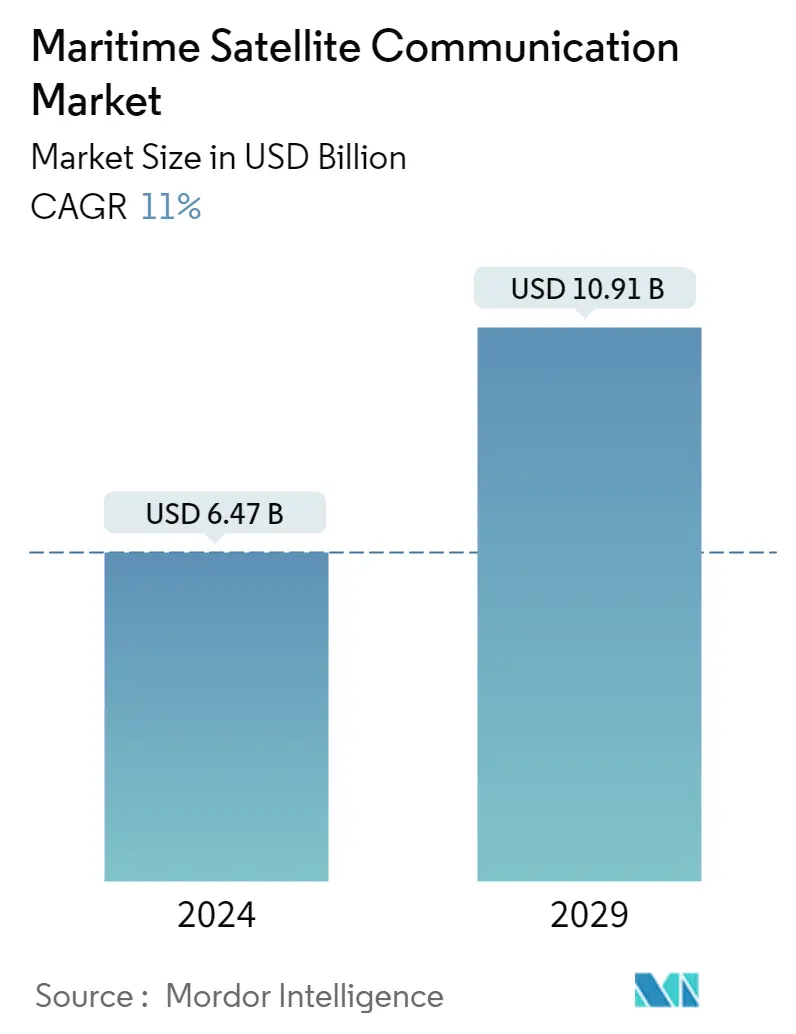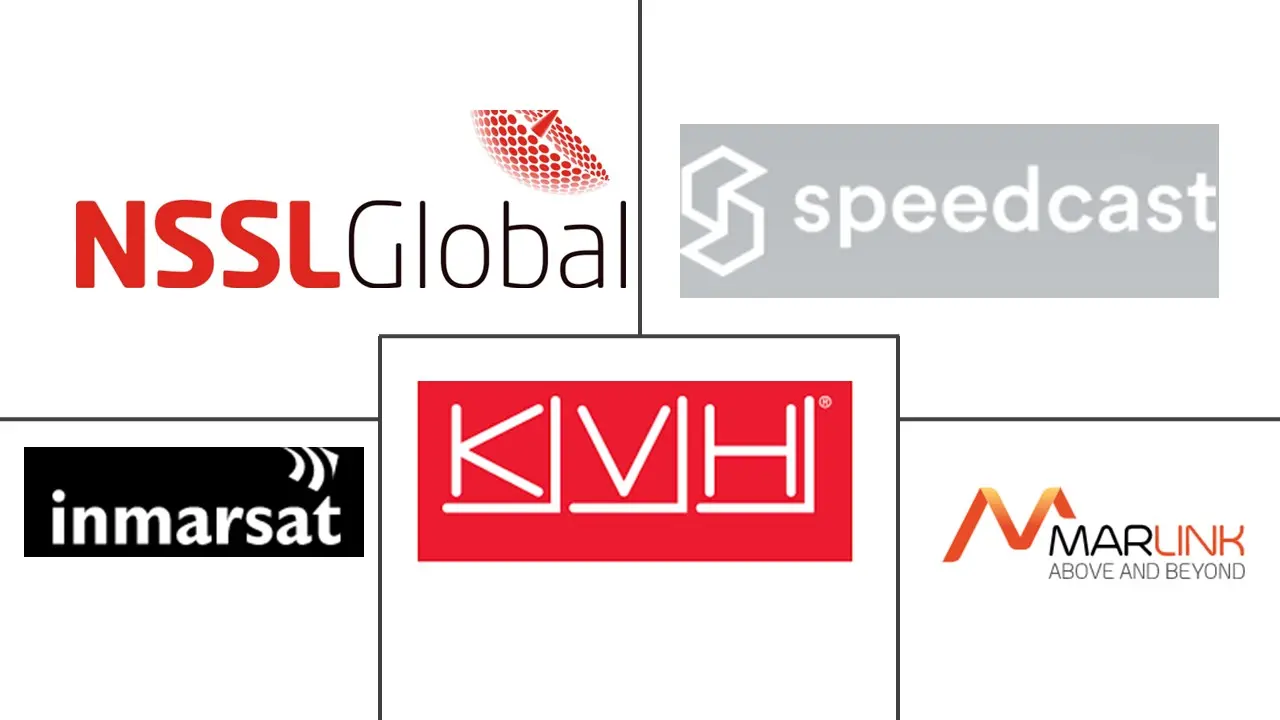Market Size of Maritime Satellite Communication Industry

| Study Period | 2019 - 2029 |
| Market Size (2024) | USD 6.47 Billion |
| Market Size (2029) | USD 10.91 Billion |
| CAGR (2024 - 2029) | 11.00 % |
| Fastest Growing Market | Asia-Pacific |
| Largest Market | North America |
| Market Concentration | Low |
Major Players
*Disclaimer: Major Players sorted in no particular order |
Maritime Satellite Communication Market Analysis
The Maritime Satellite Communication Market size is estimated at USD 6.47 billion in 2024, and is expected to reach USD 10.91 billion by 2029, growing at a CAGR of 11% during the forecast period (2024-2029).
The primary market growth drivers include rising demand for broadband connections, VSAT connectivity, and high-throughput satellites to enable cloud and IoT applications. According to the Department of Telecommunications (India), in 2023, the total number of internet connections in India reached close to 851 million. The connectivity has almost tripled in the past few years, compared to 302.33 million connections.
- The ability to track cargo and ships worldwide is made possible by satellite communication systems. VSAT terminals are communication instruments that enable text, audio, and video data transmission and reception over satellite-based broadband internet assistance. These terminals are geostationary satellites on the Ku, Ka, and C bands. Service providers would require even greater capacity, performance, coverage, and flexibility to meet the maritime industry's changing needs, where end users have a wide range of communication needs. Furthermore, Service providers must be able to expand networks to meet consumer demands swiftly. Customers need help using satellite solutions due to the growing use of maritime satellite technologies.
- The rising demand for applications such as audio broadcasting and voice communications in end-user industries is projected to propel the growth of the satellite communication industry. For instance, in March 2023, Tata Communications launched a new cloud-based application, Jamvee, with integrated voice calling and messaging capabilities for enterprises. With flexible plans for voice calling and data roaming, Jamvee is a cost-efficient solution for the employee collaboration needs of enterprises.
- Crew welfare is made possible by digitalization's quick connectivity for VoIP conversations, messengers, and video conferencing. Smaller ships typically need more room or space for an expensive satellite communications setup, while large ships are quickly adopting new digitalization methods by VSAT communications. Orion Edge V provides a VSAT-like experience on little hardware for all vessels and allows for optimized applications through the OneGate platform for video conferencing, telemedicine, remote maintenance, and IoT. The Thuraya MarineStar terminal, which provides voice services like a public phone, and the Thuraya Orion IP broadband terminal, which offers data services, can be used as a primary communication system for small vessels.
- In May 2023, Viasat Inc., a global communications company, celebrated the successful launch of its ViaSat-3 Americas satellite. The satellite was launched aboard a SpaceX Falcon Heavy from Launch Complex 39A (LC-39A) at NASA’s Kennedy Space Center in Florida. Just 15 minutes after liftoff, the first signals from the satellite were acquired through a ground station in South Korea. Such developments in various regions may further propel the market's growth.
- Furthermore, the growing number of IoT-connected and sensing devices, such as autonomous shipping, performance computing, fleet management, and cybersecurity applications, is driving the demand for satellite communication. For instance, in November 2023, leading the charge in satellite communications, Viasat Inc. teamed up with Skylo Technologies, a prominent non-terrestrial network (NTN) service provider, to introduce the world's inaugural global direct-to-device (D2D) network. This groundbreaking move, facilitated by a global infrastructure agreement between the two companies, marks a significant milestone. It will empower mobile network operators (MNOs), device manufacturers, and chipset makers to bring 3GPP Release 17 compliant products to market, leveraging Viasat's extensive global network coverage.
- Companies also adopt voice-based mobile satellite services to connect employees with their families and close friends. For instance, Inmarsat offers a service called ChatCard, which assists in reducing feelings of isolation at sea by providing crewmembers the freedom to stay in touch with relatives and friends anywhere. The American communications firm Viasat Inc. is headquartered in Carlsbad, California, and has other domestic and abroad operations. Viasat provides secure networking solutions and high-speed satellite broadband services for the military and commercial markets. In the fiscal year 2023, the corporation made USD 1,210.7 million from the satellite services segment in revenue. Viasat's revenue has been steadily increasing.
- However, a lack of awareness about advanced maritime satellite services and the reliance on high-cost satellite equipment are hampering the market’s growth. Furthermore, high-throughput satellites to unlock cloud and IoT services and the unification of satellites and cellular communication technology will likely provide lucrative development opportunities for maritime satellite communication demand in the coming years.
- Moreover, inflation significantly impacts the market studied, as it can lead to higher costs for satellite communication industries. This can be due to various factors, such as higher prices for raw materials, increased shipping costs, and labor costs and shortages. As a result, manufacturers may be forced to raise their prices to maintain profitability, ultimately decreasing the demand.
Maritime Satellite Communication Industry Segmentation
Marine communication involves ship-to-ship and ship-to-shore communication. Over the years, how seamen communicate has changed drastically. Previously, semaphores and flags were a primary form of communication for ships out at sea. Maritime satellite communication comprises a range of communication service offerings delivered mainly through Ku-band, L-band, and Ka-band frequency-based satellite communication services, which help communication worldwide.
The market is segmented by types, such as mobile satellite communication or mobile satellite services (MSS) and very small aperture terminal (VSAT), among solution and service offerings. The study also comprises various end-user verticals such as merchant, (cargo, tanker, container, bulk carrier), offshore rigs and support vessels, passenger fleet (cruise and ferry), leisure (yachts), and finishing vessels in multiple geographies such as North America, Europe, Asia-Pacific, and Rest Of The World. The impact of macroeconomic trends on the market is also covered under the scope of the study. The disturbance of the factors affecting the market's evolution in the near future are also covered as drivers and constraints. The market sizes and forecasts are provided in terms of value (USD) for all the above segments.
| By Type | |
| Mobile Satellite Communication or Mobile Satellite Services (MSS) | |
| Very Small Aperture Terminal (VSAT) |
| By Offering | |
| Solution | |
| Service |
| By End-User Vertical | |
| Merchant (Cargo, Tanker, Container, Bulk Carrier, etc.) | |
| Offshore Rigs and Support Vessels | |
| Passenger Fleet (Cruise and Ferry) | |
| Leisure (Yachts) | |
| Finishing Vessels |
| By Geography | |
| North America | |
| Europe | |
| Asia-Pacific | |
| Rest of the World |
Maritime Satellite Communication Market Size Summary
The maritime satellite communication market is poised for significant growth, driven by the increasing demand for broadband connections, VSAT connectivity, and high-throughput satellites. These technologies are essential for enabling cloud and IoT applications, which are becoming increasingly important in the maritime industry. The ability to track cargo and ships globally is enhanced by satellite communication systems, which facilitate the transmission of text, audio, and video data over satellite-based broadband internet. As the maritime industry evolves, service providers are required to offer greater capacity, performance, and flexibility to meet diverse communication needs. The adoption of satellite solutions is further propelled by the rising demand for applications such as audio broadcasting and voice communications, which are crucial for crew welfare and operational efficiency.
The market is characterized by the entry of established wireless satellite communication service providers and the introduction of innovative solutions like OneWeb's "Try Before You Buy" maritime service. These developments are fostering a competitive landscape, with major players focusing on expanding their customer base and enhancing their service offerings. The Asia-Pacific region, particularly countries like India and China, is expected to be a key growth area due to the increasing use of waterways for transportation and government initiatives supporting maritime infrastructure. However, challenges such as high costs, lack of awareness about advanced services, and inflationary pressures may hinder market growth. Despite these challenges, the market presents lucrative opportunities, especially with the unification of satellite and cellular communication technologies and the growing number of IoT-connected devices in the maritime sector.
Maritime Satellite Communication Market Size - Table of Contents
-
1. MARKET INSIGHTS
-
1.1 Market Overview
-
1.2 Industry Attractiveness - Porter's Five Forces Analysis
-
1.2.1 Threat of New Entrants
-
1.2.2 Bargaining Power of Buyers
-
1.2.3 Bargaining Power of Suppliers
-
1.2.4 Threat of Substitute Products and Services
-
1.2.5 Intensity of Competitive Rivalry
-
-
1.3 Technology Snapshot (Ka, Ku, and C Bands, Size of Terminals, Application Notes, and Penetration)
-
1.4 Impact of Macroeconomic Trends on Maritime VSAT and Allied Markets
-
-
2. MARKET SEGMENTATION
-
2.1 By Type
-
2.1.1 Mobile Satellite Communication or Mobile Satellite Services (MSS)
-
2.1.2 Very Small Aperture Terminal (VSAT)
-
-
2.2 By Offering
-
2.2.1 Solution
-
2.2.2 Service
-
-
2.3 By End-User Vertical
-
2.3.1 Merchant (Cargo, Tanker, Container, Bulk Carrier, etc.)
-
2.3.2 Offshore Rigs and Support Vessels
-
2.3.3 Passenger Fleet (Cruise and Ferry)
-
2.3.4 Leisure (Yachts)
-
2.3.5 Finishing Vessels
-
-
2.4 By Geography
-
2.4.1 North America
-
2.4.2 Europe
-
2.4.3 Asia-Pacific
-
2.4.4 Rest of the World
-
-
Maritime Satellite Communication Market Size FAQs
How big is the Maritime Satellite Communication Market?
The Maritime Satellite Communication Market size is expected to reach USD 6.47 billion in 2024 and grow at a CAGR of 11% to reach USD 10.91 billion by 2029.
What is the current Maritime Satellite Communication Market size?
In 2024, the Maritime Satellite Communication Market size is expected to reach USD 6.47 billion.

